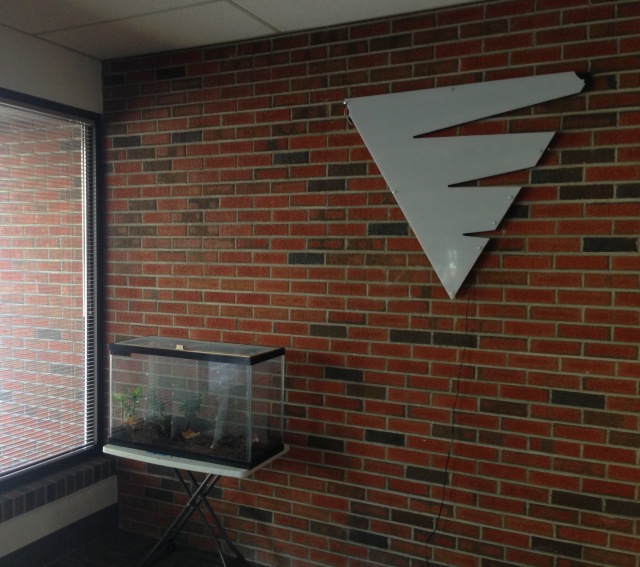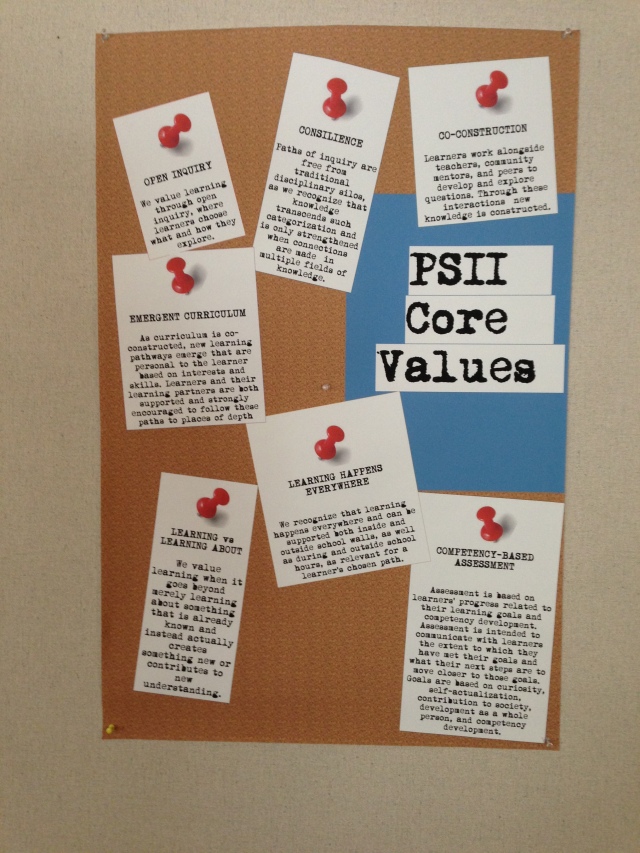A few days my classmates and I had the privilege to visit the Pacific School of Innovation and Inquiry (PSII) in downtown Victoria. PSII (@PSIIvictoria ) is a high school that runs very differently than the high school my peers or I attended; students don’t go to classes from 8:30-2:50pm every day, there really is not any set homework, and their school is set amongst the office buildings of downtown Victoria (as opposed to a typical school building).
You may be thinking, this is a school? What do they do there?

Don’t worry, I felt that way too before my visit to the school on Tuesday.
Principal Jeff Hopkins (@hopkinsjeff) talked to my peers and I about how the school operates upon our arrival to the school. It is a grade 9-12 school in which students walk into and are asked “What would you like to learn?” The students then get to individually think of something they would like to learn about. It can be anything. Then they begin to formulate questions about their topic they would like to answer, talk to teachers, and begin to gather resources to study their topic. This is inquiry-based learning in its purest form.

Practically speaking, every student at PSII has a Trello board that their teacher has access to as a way to organize the steps the student wants to take to reach their goal. Students also have group Trello boards for collaborative projects with their peers. The Pacific School of Innovation and Inquiry has created these inquiry projects guides for students to use to begin their projects (I have used this one as a loose guideline for developing my family history open inquiry project). Students are also encouraged to keep three projects on-the-go, and complete these by the end of the year.
In regards to classes, students all have a version of a ‘home room’ classroom with twelve other students where attendance is taken and other ‘housekeeping’ items are taken care of. The teachers of each of the home rooms are responsible for checking in with these twelve students and how each of them are doing with their projects. Just like in more traditional high schools, each teacher specializes in at least one particular field (i.e. English, History, Physics, etc), but that doesn’t mean their group of twelve students need to keep their projects within their teacher’s field of study. If their project involves physics or math and their homeroom teacher is a specialist in English, the teacher will refer the student to talk to the teachers at the school who are specialists in physics and math.
From what I gathered from students, they have a much more professional but caring relationship with their teachers than I had with my teachers in high school. The students are on a first-name basis with their teachers, and while the teachers do spend half their time leading organized classes around particularly topics that students can choose to attend, the other half of their day is spent checking-in with their twelve students to determine how their projects are going, and scaffolding the learning process as the teachers can.
Students also have different relationships with each other. Because students are stuck in classes organized by grade (they fulfill the requirements of each of the subjects at their own pace), there is room for a lot of cross-grade collaboration on different projects. I think this is so great. The artificial boundaries we have made that segregate students by age in a more traditional high school setting prevent students from building relationships that allow them to be mentored by students older than them and mentor students younger than them. Also, students will learn (as I have), that age is just really a number once you get out of high school.
“I wonder if…” “What if…?” “I wish I could learn…”
Have you ever caught yourself asking any of these questions in the midst of a conversation? I know I have!
At PSII, students get to actually DO something with these questions.
Hands-down the most inspiring part of my visit to PSII was talking with the students. Their project ideas are amazing! Here’s a few projects Grade Nine students are working on that I learned about:
- One student is working on designing a bus that runs off a typical cooking ingredient as fuel. She will need to learn about how a bus runs (Mechanics, Math, Physics), and sustainable and alternative energy (Physics, Environmental Studies) to be able to do this. Oh, and she also wants to be able to take her bus on a trip across the continent!
- Another student is researching how art is made with virtual reality (VR) software and controllers. He showed me and a few of my peers how he made a 3D picture, a statue, and graffiti on a VR brick wall all using VR technology and controllers! This would have required him to learn about VR software (Technology, Computer Science), and different art mediums (Art)
- Another student is learning Serbian. He expressed to his teacher that the way he learns best is by teaching others, so he holds organized classes throughout the week teaching his peers and even his teachers (!!) what he has just learned in that week. Sticky notes can be found around the school labelling different items (such as doors) with their Serbian words. Jeff expressed how he already has homework for this student’s class.
As I talked to the students, I kept thinking about my own elementary, middle, and high school experiences, and how cool it would have been to have had the autonomy and freedom to even occasionally work on a project of my own creation and have my marks based upon that. I don’t even know what I would have learned based on the projects I would have chosen. I’m grateful for the opportunity to be conducting two different inquiry projects in the Technology class I am currently in now to experience what it is like (see my first blog post for my open inquiry project on family history here, and my group’s first blog post for our technology inquiry project on outdoor education and networked technologies here).
The more I think and reflect upon how teachers are using more open inquiry projects and student-guided learning practices in their classrooms, I’m warming up to the idea of lead open (but teacher scaffolded) inquiry projects with my elementary or middle school students one day. It is hard for me to think about giving up that control of knowing what the outcome of their projects would be like, but I think seeing what they come up with as a result, something that they are hopefully proud of and is meaningful to them, will be worth it. Even if I don’t lead open inquiry projects with my students all the time, I want to find ways for students to have their voices and opinions heard more in the classroom, particularly around choosing different items to study (ie picking between a couple different novels for novel studies, helping write up a classroom code of conduct, etc).
I’m feeling inspired by these new ways of approaching education, and looking forward to learning more about the products of open inquiry learning as I undertake open inquiry projects of my own.
~Bethany
